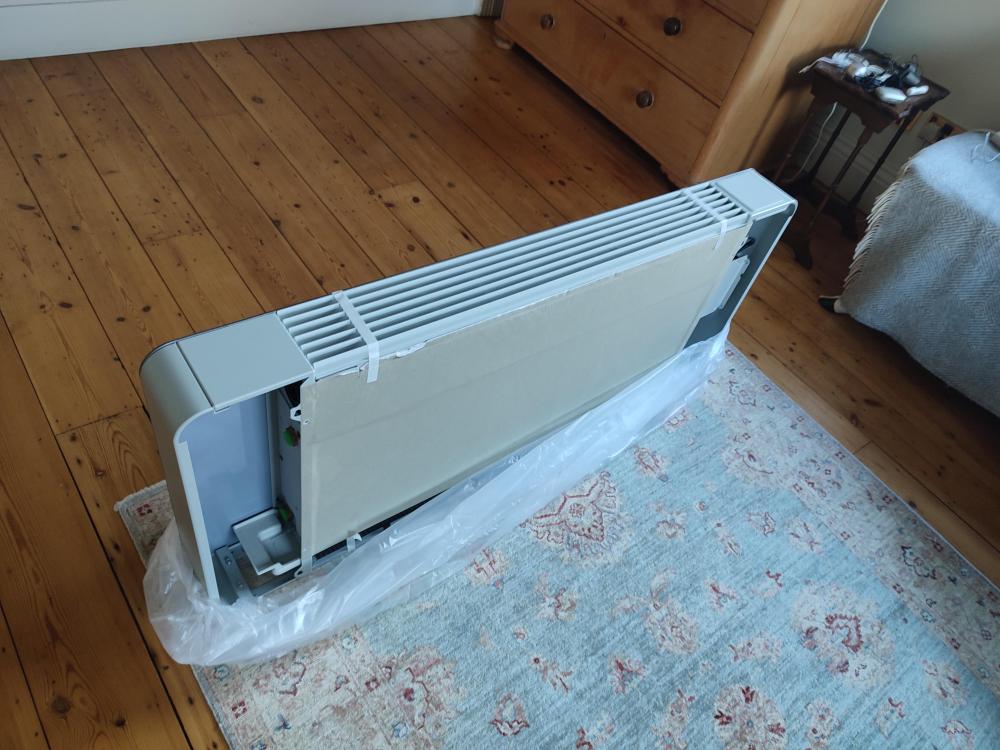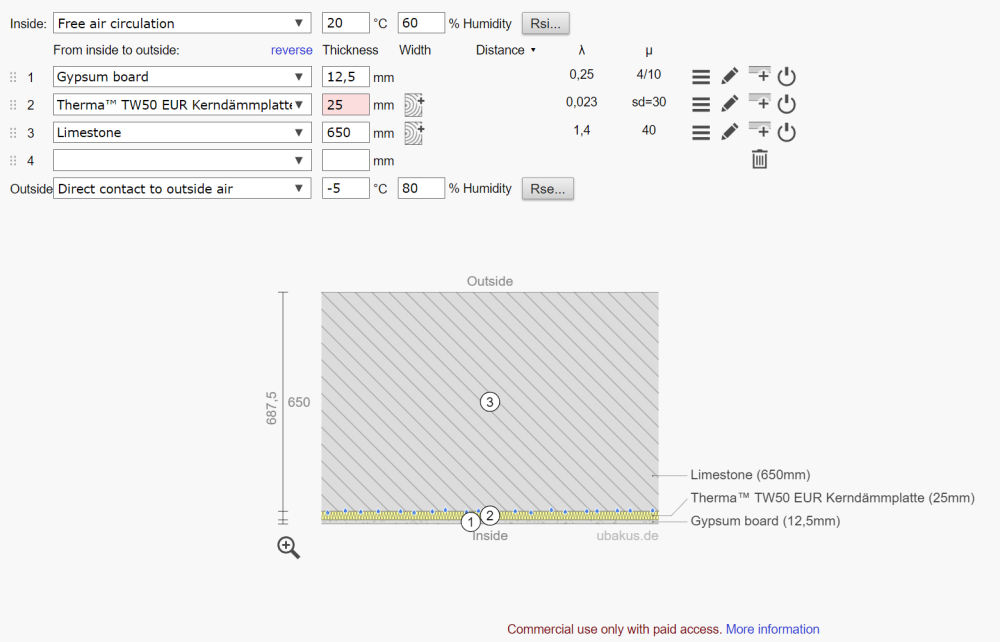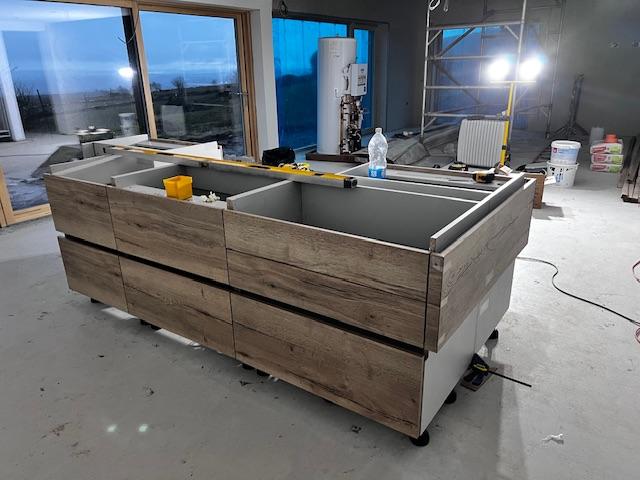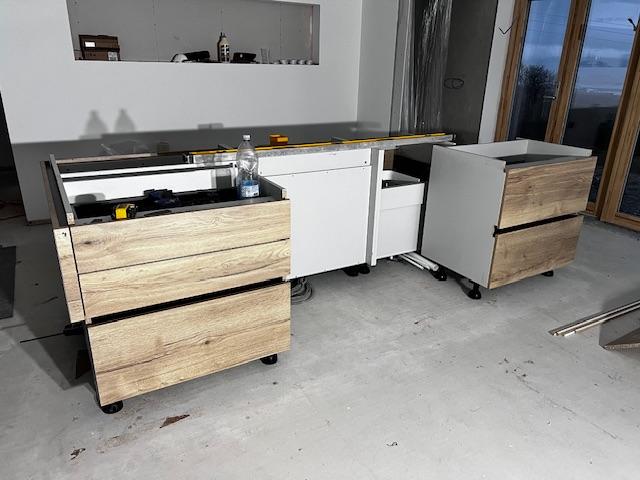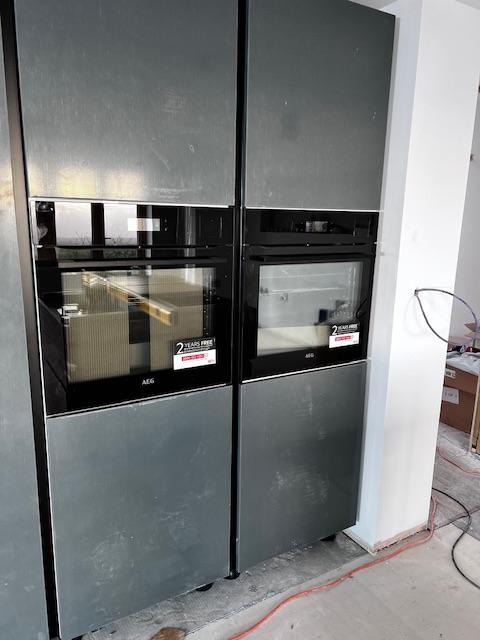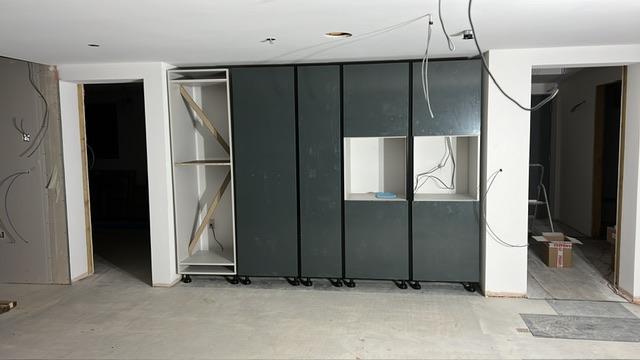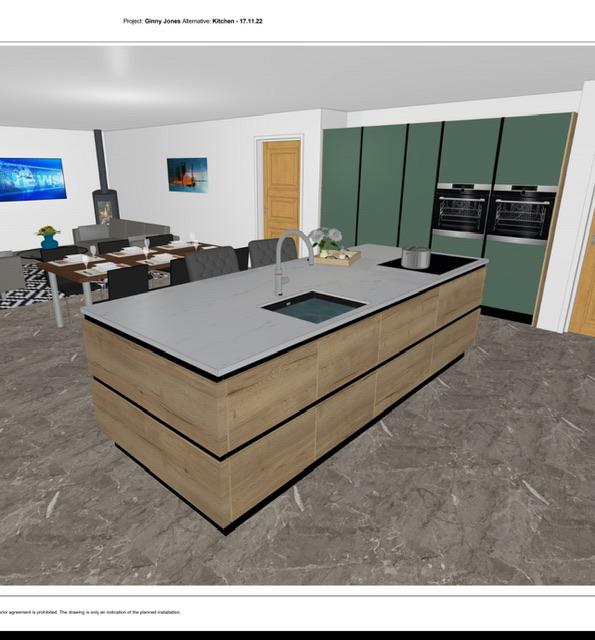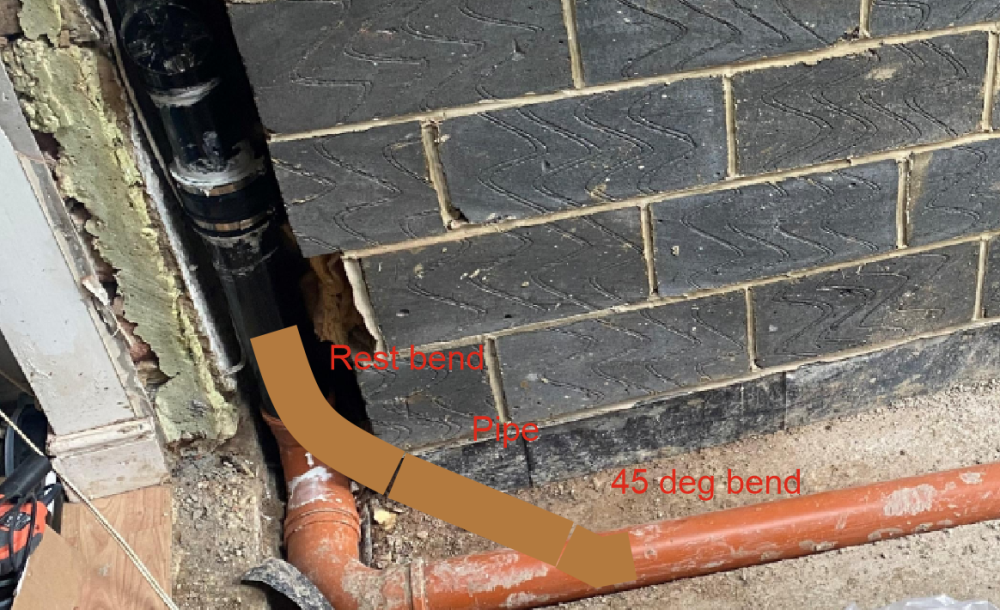Leaderboard
Popular Content
Showing content with the highest reputation on 01/08/24 in all areas
-
OK, unit arrived. Well packed. It's a bit of a beast (fs800) slightly over 1200mm wide (a bit wider than spec) and abut under 600mm high. Pretty thin - 120mm as advertised - about the same a k22 rad. Build quality seems good. One interesting thing is the ends are about 150mm wide each and are mostly fresh air. They are for making the hydraulic and electrical connections. But it strikes me most rads have the valves exposed on the side anyway. It's sort of expected so doesn't look odd to most people. So they coukd make a unit with the same performance, but a nominal. 900mm wide (the width of the actual core) and have the inlet and outlet at each side on the bottom, like normal rads. If the ditxhd the fancy glass front for a pressed steel flat front it would d be a pretty standard looking rafiator, just able to provide the same output at a much lower flow. The smiths powerad looks sort of ideal but it's price is a but high and performance wasn't as good on paper. Let's see how it performs.3 points
-
Many years ago I had a problem with water running off the road onto my drive. I spoke to Highways about it and they put a 40mm high mound of tarmac along the length of the drive. They said 40mm was the highest they could safely put it.2 points
-
That kind of cash would make it a much more attractive idea. At a rough guess for a 180m2 house. High quality MVHR unit ex ducting and manifolds. £2.5k ESHP cylinder for DHW £2500k A2A unit for space cooling+heating. £1000. A bit of money saved because of avoiding a few different installers. Catching up on an old thread earlier I saw a Genvex unit had only failed after 25 years. It could persuade me for a passivhaus.2 points
-
Since MI's make no mention of a switch I would be happy fitting just a FCU if that is what the customer wants. Ask him to show you where in BS7671 it says you have to have a switch.2 points
-
What is wrong with a convector heater with a simple heating element, a timer and thermostat built in. I took a major dislike to "posh" electric heaters when the wonderful EU introduced "LOT20" intending to make electric heaters more efficient by enforcing electronic controls. The first one I installed, I removed a week later, as the customer just could not understand the controls, and it kept shutting down with a message "window open detected" What a load of rubbish.1 point
-
I think there's a place for means tested grants for fabric upgrades. It's a positive way to make progress on net zero, build up the industry, tackle energy poverty and housing crisis, and ensure the hand outs actually go to improving the wellbeing of the children in the house and rather than wherever else it might end up if it was just handed out as cash1 point
-
As @Russell griffithssaid do not use cling film stuff, I spent about 5 hours 1 evening until 11pm getting up about 1.5sq/m before the customers furniture turned up the next day for them to move in. Antinox and tape to edges cut back for skirting, it will not stop damage from dropping sharp or heavy things, do not cut anything on it either as is no protection to a knife. Hardboard is a good idea1 point
-
I bought a sink from Vieffetrade and they sell all manner of things. They're based in Italy but buying from them was quite a bit cheaper than in the UK - even when shipping was included. I was sligghtly concerned but the comms from them were really good and it arrived after a couple of weeks. It was well packaged on a crated pallet and was sent via air freight to us.1 point
-
Daytime high of -2 today, forecast -8 tonight. Stove burning nicely. I collected a load of firewood in the Landrover last weekend and going back for more this weekend. This will be for next year or more likely the year after. Chainsaw was busy Saturday afternoon.1 point
-
That’s all well and good but what’s the bloody answer🤷♂️1 point
-
TV Wall - maybe consider a TV set into a fabric covered wood frame. You can more easily increase size if you need to and can also have speakers set behind the fabric so can provide a nice looking solution with some flexibility1 point
-
Memory tells me there is a bitumen tack paint, with a lot of solvent in it to make the existing bitumen sticky. Failing that then any bitumen paint probably. Tarmac is only about 5% bitumen, and the surface wears down to all stone, so there won't be much to melt.1 point
-
Your Architect is wrong. You cannot combine PD and PP connecting extensions to achieve what you want. Your options are to build out the PD or PP extension. You can of course submit an application that combines both extensions and should that be refused, Appeal. Obviously there is a chance of the Appeal being dismissed and there are long extended time periods with that approach.1 point
-
Simply because the flow temperature are low. You can't have a flow temp of say 30 deg, a room temperature of 20 and return temp of 10. The return temp cannot be lower than the room temperature, to get satisfactory heat transfer to the room the return temperature will also be above the room temperature. The more work the heat pump has to do the less efficient it becomes. A low temperature gas boiler is exactly the same.1 point
-
Even without "rising damp", it's a condensation risk. It's a good improvement in U Value 1.5 -> 0.565, but moisture collects between the PIR and Stone wall. Temp on the left and humidity on the right. But, the condensation may not be an absolute risk. It shows from 1° and below it's a risk, but it doesn't consider how long the temp needs to be below 1° for it to stabilise. The 650mm wall has a 23hr decrement delay, so it's got to be down at that temp for over a day before the inner face could drop below dew point.1 point
-
Everybody knows what it means though. https://www.greenspec.co.uk/building-design/thermal-mass/ https://www.designingbuildings.co.uk/wiki/Thermal_mass_in_buildings1 point
-
If the got their old O Level Physics books out it would help. I have to agree that home owners should not get grants. They will be the same home owners that complain about the amount of tax they pay. Or how much they are scammed by the energy companies. There was something on the radio today about Mouldy Homes (again). Seems to be single parents with small children that are interviewed the most. I suspect it would be cheaper for the housing association to just pay the energy bills that try and upgrade the properties with the tent in there. When tenant moves, then upgrade. I also suspect the same tenants have the same problems i.e. can't afford the energy, lots of mould, whichever home they are sent to.1 point
-
Don’t let @SteamyTea catch you using “thermal mass” he will get his knickers in a twist 🤣🤣🤣 I don’t know the figures but insulating internally will make the room heat up quicker , thermal mass (sorry) will store heat but needs heating so will absorb heat out of the house but keep heat levels more stable.1 point
-
I don’t see why the government should pay for you to upgrade your draughty 1930’s house because you haven’t done anything to it in the last 20 years. People need to be a bit more responsible for themselves. All a grant will do is manufacture loads of new crappy insulation companies1 point
-
1 point
-
Typically don't pack full. Our studs were 89mm and i think we used 50mm mineral wool. Consider using i) double soundbloc and ii) resilient bars (on one side at least) for best results.1 point
-
Inspection by kitchen supplier prior to templating ( happening tomorrow ) said “ it’s spot on “ 😊1 point
-
Cheers ! My concern on switching is it messes up the "smart" bit so will ask him to justify the switch tbh and go from there.1 point
-
Your ceiling should be the same as the others in the house - not sure how many storeys but it's going to be at least modified half hour. Plasterboard and skim will give that. The floor isn't a compartment floor so there is no specific requirement to fire stop a penetration but I'd make the hole for the cables as small as possible and foam up the spaces left. If they are surface mounted in the cupboard presumably they'd be in a trunking so as to look neat.1 point
-
I butted tight to the walls with the black plastic stuff, then cut it back room by room to fit skirting and so on, as things have progressed. The black plastic is 100% useless for stopping dropped chisels and things, it is only good for spills and plaster splashes and stuff, definitely need timber boards if anybody working from steps and towers, a dropped claw hammer will make you have a heart attack.1 point
-
You have to actually click/tap on the name from the drop down list. @joe90 is not the same as @joe90 @krev You may notice that in the above image there is a "choose file" link. This is used to add pictures. There is some slight differences between adding files, sometimes you can copy cna paste one in, and other times you can't. The choose file option will work for everything that is not too large, or the wrong sort. If you are really an IT ludite, and there is no shame in that, you may want to ask someone to help you understand Spreadsheets. They really are going to be your friend.1 point
-
I fitted a Genvex Combi 185LS back in 2017 and IIRC paid around £5000 buying it direct from Denmark. At the time it was around £8000 from Total Home Environment. The reason for buying it was that it's a compact unit offering MVHR, DHW and warm air heating and it worked well in our PH. The only downside was it had an enamelled steel DHW tank with an anode.1 point
-
The water is so muddy it will just fill up with silt. He needs to stop it getting down to the house. Enough rain and the house will be flooded.1 point
-
Are you able to divert the lower point of the aco back to the road or verge? Or cut the end off it and extend the cut beyond your grounds? Remove the metal top and just leave it as an exposed channel during the winter?1 point
-
That's the easy way. It is often best for it to be diagonal across the track, whatever keeps the water moving downhill. Farmers are supposed to plough along the contours, so the field holds maximum water. I don't think anyone imposes this though.1 point
-
Typically you try and have the ICF bracing system on site prior to start and install as soon as needed, building ICF in vertical stages would typically make the project cost prohibitive just in concrete pump trucks plus the additional .5-1 m3 of concrete needed each time you place concrete. With the exception of tornado style winds, ICF when braced prior to concrete placement holds up quite well, perhaps a bit of adjustment needed after the winds prior to placing concrete1 point
-
That I think is very good comment. Without any commitment to supporting a practical and rational level of regulation / enforcement, everything else - all of it - is mere weasel words.1 point
-
This ^^^^^^^ As i may have mentioned before (!), if we could actually achieve current regs, consistently, across the board, that would be a start. More regs that no one abides by is going to have no practical effect. I dont see any moves to tackle that. Though if you did, the end result would be the same, the flow of new houses would reduce to a trickle.1 point
-
So £5K for 13.5kWh assuming I can install myself for £0 The key to working out the economics is what is the rated number of charge / discharge cycles of the battery? Google suggests 4000 cycles. So assuming you can store the rated capacity and use it each day, that will be 13.5 * 4000 = 54,000 kWh of stored power before end of life. Divide by the cost, £5000, then you get 9.2p per Kwh as the cost of storing your energy. Assuming your off peak is 15p cheaper than peak, then the real world saving is barely 5p per kWh1 point
-
There’s a trail about the road that runs past our plot that runs with water in the winter so much it overflows onto the road and into our garden. I cut shallow trenches in the trail at angle against the water and built up the back edge of each trench. The water now runs down the opposite side of the trail and into the ditch rather than across the road. It needs maintenance though every month or so.1 point
-
What is needed is drainage ditches across the driveway. I don't know how to describe what i see often but a 6" wide trench across the drive with a hard edge both sides, a car will drive over it slowly (inverted speed hump) and the water will run into the channel and off to the side. Of course it relies on somewhere for it to run to but onto (note ONTO not under) a field will do. The whole point is keep it on the surface and push it onto adjoining land to soak in or run off. Trying to lose that much muddy water will just clog any underground soakaway. A neighbour here achieves the same thing with a speed bump across his driveway, it pushed the water down hill past his drive to carry on down hill and be someone elses problem.1 point
-
He needs to learn about ‘no-till’ farming which is becoming all the rage. Groundswell try to educate farmers away from this type of farming which depletes the soil and is not sustainable in the long term.1 point
-
Mine is not warm to touch, but not cold either. Our rooms are around 20 to 21, the floor is only a couple of degrees warmer. Poor insulation (U values) required to get a warm floor.1 point
-
Feckin farmers. The hoops I had to jump through and measures I had to take to stop silt running off my site in to the river was huge. I had to provide a report with photos proving I'd taken the required steps. Mean while farmer Willie up the road has a 10 acre field ploughed bear all winter, loses 10s of tonnes of soil every time it rains. Totally fine.... That's serious run-off... I think you need something like a cattle grid with massive sump, with overflow going to a ditch or watercourse. Or speak to the council / highways?1 point
-
Yes anything like that could mark the alu cladding. Ours said to make sure we kept the cladding free from any run off from the building materials. Ours weren’t so bad because it was just the run off from the wood cladding treatment so I just had a soft cloth and clean water on standby for a few weeks.1 point
-
Made a bit of progress over Christmas. Continued with second fix electrics, bit more painting, nearly finished the garage electrics, ceiling speakers installed, cinema room track lights installed, all prep for the ASHP and HWC cylinder done. Also started with the main kitchen. I decided to let the kitchen company install it as their guy has a very good reputation and wasn’t too dear.1 point
-
Do you really want them moved a few inches, or a lot further? If the supply head is mounted on a board and there is slack in the cable an understanding electrician might move it, you have already sad the gas people would move there's a few inches as well. The problem with moving the whole lot is the DNO have to move the supply head then the energy provider has to move the meter. In between those you are without power. Best of luck coordinating that to happen the same day.1 point
-
@eski009 - btw as a newbie to the forum, just so you know - the forum etiquette is that if you ask a question and people take time and energy responding, then you implicitly agree to consider the replies, and reply yourself etc. I'm not singling you out, just saying that there are some people who alight on Buildhub for the first time, ask a question, people reply - sometimes at length ... and we never hear from the original questioner again. OK I think you might have a snag - I've come across this myself. Like other UK tax laws, the CIL law ( https://www.legislation.gov.uk/uksi/2010/948/contents ) is very fragile, which means if you put a foot out of step, even accidentally, you get nailed. Fair? No. I also think that the CIL law is 'interpreted' by your local LPA - so not all LPAs read or implement CIL the same way. Also, I don't think there are many experts on CIL - I had a commercial property lawyer (read 'grown up') for my plot and she sad 'we cannot advise on CIL'. I don't think she realised that it was even part of the planning legislation. I have not read the legislation (yet) but I had this interaction with my local LPA's CIL department last summer. As the plot had planning already, I asked whether I could put in my services, driveway etc based on the old permission while I was waiting on them to decide on my new permission: "We would like to start getting the services and access arrangements started on this plot. The applications listed above are for the same single dwelling plot, a ‘greenfield plot’ located at xxx yyy. Planning was granted for a single storey dwelling under zzz back in November 2021. We have since proposed two variations in design for LPA consideration and these are still waiting for decisions - which we are told will be forthcoming over the next week or so. We have been told that the single storey design will be granted and the 1.5 storey design refused. We intend to take the latter to appeal. This is a self-build. The access arrangements, cart lodge etc are the same in both of the outstanding designs – it’s just the dwelling itself that varies. As we already have planning granted for a single storey dwelling, we would like to make a start on the installation of services and for the driveway for access. I imagine that we can simply signal a formal start under the original application and then ‘move the CIL arrangements’ as the new planning and/or appeal comes through. Would that be correct? If so, what is the correct procedure for ‘moving the CIL arrangements’?" They answered: "If your new applications were variations of the original consent, it would be possible to transfer a self build exemption across, however, as you have made new full applications this becomes somewhat more complicated. You cannot transfer a self build exemption from one full application to another. If you make a start and carry out a material operation to commence development, you could invalidate any possibility of claiming exemption on an alternative permission. Given the access arrangements are the same, you would effectively have already implemented a new permission on the day permission was granted and the CIL for it would be payable in full, immediately. I would recommend you wait to implement any permission until you have received the permission you intend to build out to avoid any potential issues down the line." This agrees with the response you got, although I imagine your local LPA CIL guys do have some flexibility. That said, they are a revenue raising team, so guess what - they probably love the fragility of their interpretation of the CIL law. So I suggest, a possible way around is to try to vary your original application (there are various mechanisms for that) so it's not a new application, just a variation of the old. That might mean some compromises in you design - maybe so it looks the same as the old to the casual observer, even though you have a basement now. If your variation gets turned down, you still have the original application intact. This assumes you have a bit of time to wait for the LPA's response. They may still refuse to vary based on the fact that it's an increase in floor area. But they may not. I found my local CIL guys a lot more approachable that the planning guys, so maybe you could get a face-to-face to see what they might allow or whether they might give you an exemption so you just pay the uplift for the extra floor space. They might decide it's a question for the planning guys and send you there or might take the question to the planning guys themselves. If you are a risk taker and have a good lawyer and the CIL law supports your position then you might also ignore their response, and be prepared to fight in the courts later. Do let us know what happens - I for one am still interested in this question. Also it builds the level of Buildhub knowledge.1 point
-
Yes. Two options. Cut the hole and fit the meter box and see how it goes. You might need to scrab away some mortar in the cavity to make it work. If it's sitting a few mm proud, then a bit of sealant will do the job. If it's sitting out a fair bit, you can build a brick surround up against the face of the wall where the meter boxes are, then you'll have plenty of depth. You'll need to do some flashing at the top to keep water away, and make sure dpc is not bridged, otherwise simple job. From memory it's your responsibility to fit the meter boxes in accordance with their spec, along with any customer side works, then your supplier will arrange via the DNO to move the apparatus. The guys installing the meter and moving bits around won't care as long as they can do their job.1 point
-
I paid for the application in August 2023 to allow me to get on with getting the footings in for the extension (and have them inspected). I then spent 3 months maybe, doing the plans in the evenings. I finally submitted them in October. They came back after about 6 weeks and asked for some ammendments (that are included above) and finally got approval 19th December 2023.1 point
-
1 point
-
1 point
-
I’ve seen them in the flesh in the Cool Energy trailer at the installer show. They are very nice units and are quiet in operation. Much nicer than the smiths ecovector that we ended up using (because they were the only ones that would fit over the doors). The wiring on the reverso ones does look a little complex though. The smiths have a built in thermal switch that will turn them off until the flow temp hits 37-38. Reverso units are rated for cooling though.1 point
-
It's because, I think you have many years experience as a Contracting Engineer, you are widely read, pragmatic, thoughtful but at the same time your head does not zip up the back, just like a lot of folk on BH. I enjoy BH as I would rather spend my time sharing what I know and I do feel that lots of other members feel the same, you give, receive and learn. @Declan pulled me up for putting BH at risk from spammers, I learnt from that. Sometimes it's the small things that matter, maybe the odd kick up the arse at times helps a lot. I'm in a slightly different space. My PI insurance covers me for free advice I give and opinions I express. That allows me to use my own name on Build Hub so long as I'm not daft. That is why I don't have to caveat every post I make. I pay a bit extra for free advice I give in my premium and that includes BH and other social media. I use my own name as I feel that if you can't stand by what you say then zip it. Also if you want to pipe up then expect some folk will disagree with you. If you can't handle that then.. zip it. Many modern journalists are a disgrace to their profession, they have no moral fibre, many are pathetic individuals who will sell themselves to the highest bidder, but we already know that.1 point
-
0 points


